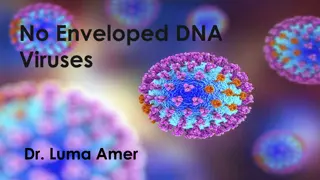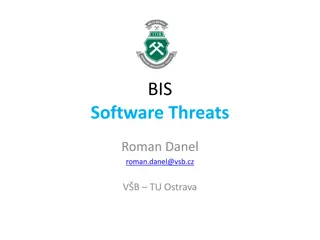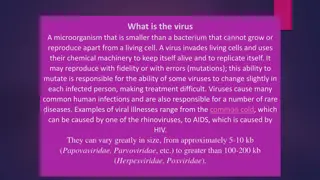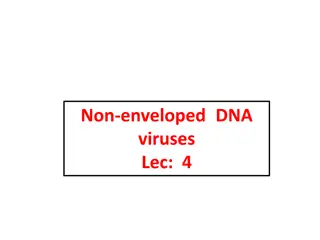Understanding Enveloped and Non-enveloped DNA Viruses
Non-enveloped DNA viruses, surrounded by a protein capsid, are resistant to sterilization and thrive in acidic environments. Adenoviruses, a common non-enveloped type, spread through close contact and contaminated objects. Additionally, Papilloma and Polyoma viruses, causing persistent infections and tumors, are noteworthy. Human Papillomavirus, with over 100 types including cancer-causing strains, poses a significant health concern.
Download Presentation

Please find below an Image/Link to download the presentation.
The content on the website is provided AS IS for your information and personal use only. It may not be sold, licensed, or shared on other websites without obtaining consent from the author. Download presentation by click this link. If you encounter any issues during the download, it is possible that the publisher has removed the file from their server.
E N D
Presentation Transcript
Enveloped and Non-enveloped DNA viruses Lec: 4
Non-enveloped DNA Viruses Non-enveloped viruses are surrounded by a protein coating, commonly referred to as a capsid. The capsid does the job of attaching to host cells. Non-enveloped viruses are difficult to sterilize. They display excellent heat-resistant properties, and moreover, can easily withstand a dry and acidic environment, also, more powerful and proliferates rapidly in an acidic environment. They can survive in some disinfection processes.
Non enveloped DNA viruses include many viruses as show below:
The Adenoviruses Nonenveloped, dsDNA 49 types associated with human disease 5
The Adenoviruses Adenoviruses are a group of viruses that are transmissible via a variety of methods: Close contact, such as touching or shaking hands coughing and sneezing Touching an infected object or surface, then touching the mouth, nose, or eyes without washing the hands first Adenoviruses can also spread through infected stools for example, during a diaper change. Some adenoviruses are contagious in water.
The Adenoviruses Infect lymphoid tissue, respiratory and intestinal epithelia and conjunctiva Spread by respiratory and ocular secretions Causes colds, pharyngitis, conjunctivitis, keratoconjunctivitis, cystitis Severe cases treated with interferon Inactivated polyvalent vaccine Adenovirus infections can be identified using antigen detection, polymerase chain reaction (PCR), virus isolation, and serology. acute hemorrhagic
Papilloma and Polyoma Viruses Small, nonenveloped dsDNA Circular DNA Cause persistent infections and tumors 8
Human Papillomavirus Papillomaviruses are small, dsDNA,non-enveloped, icosahedral DNA viruses that have a diameter of 52 55 nm. There are more than 100 types of HPV, of which at least 13 are cancer-causing (also known as high risk type). Two HPV types (16 and 18) cause 70% of cervical cancers and precancerous cervical lesions. It takes 15 to 20 years for cervical cancer to develop in women with normal immune systems. It can take only 5 to 10 years in women with weakened immune systems, such as those with untreated HIV infection.
Human Papillomavirus Common seed warts painless, elevated, rough growth; on fingers, etc. Plantar warts deep, painful; on soles of feet Genital warts -morphology ranges from tiny, flat, inconspicuous bumps to extensive, branching, cauliflower-like masses
Human Papillomavirus Transmissible contaminated fomites; incubation 2 weeks to more than a year Most common warts regress over time; they can be removed by direct chemical application of Prescription cream and physical removal by cauterization(burning), freezing, or laser surgery through direct contact or Warts can recur
Human Papillomavirus Diagnosis of Papilloma -Pap smear Early detection through inspection of genitals, women Pap smear to screen for abnormal cervical cells. -PCR Two effective HPV vaccines. Gardasil 9, and Cervarix. The vaccines do not prevent other sexually transmitted diseases, nor do they treat existing HPV infections or HPV-caused disease.
Polyoma Viruses Are unenveloped double stranded DNA viruses with circular genome isocahedral in shape. In immunocompetent hosts, the viruses remain latent after primary infection. Illnesses associated with these viruses occur in times of immune compromise, especially in conditions that bring about T cell deficiency. Their occurrence in individuals was mainly confirmed by PCR and the presence of virus-specific antibodies.
Polyoma Viruses BKV are known to cause, hemorrhagic cystitis in recipients of bone marrow transplantation Many people who are infected with this virus are asymptomatic. It is not known how this virus is transmitted. It is known, however, that the virus is spread from person to person, and not from an animal source. It has been suggested that this virus may be transmitted through respiratory fluids or urine.
Polyoma Viruses JC-Virus cause(PML)progressive multifocal leukoencephalopathy in immunocompromised patients. the initial site of infection may be the the gastrointestinal tract. tonsils, or possibly The virus then remains latent in the gastrointestinal tract and can also infect the tubular epithelial cells in the kidneys, where reproduce, shedding virus particles in the urine. it continues to
Parvoviruses Nonenveloped, ssDNA Small diameter and genome size Causes distemper in cats, enteric disease in dogs, fatal cardiac infection in puppies Few cause infections in humans
Human Parvoviruses B19erythroparvovirus cause of erythema infectiosum (fifth disease); rash of childhood Children may have fever and rash on cheeks Severe fatal anemia can result if pregnant woman transmits virus to fetus Adeno-associated virus (AAV) is a defective virus; it cannot replicate in host cell without adenovirus Diagnosis by: 1- Serology 2- Isolation 3- PCR
Enveloped DNA viruses Viruses that have a lipid membrane. Many enveloped viruses, such as HBV, Herpesviruses and Poxviruses are pathogenic to humans and of clinical importance. The lipid envelope of these viruses is relatively sensitive and thus can be destroyed by alcohols such as ethanol or 2-propanol. Enveloped viruses can be killed by disinfectants that are virucidal against enveloped viruses.
Hepatitis B Virus infection Hepatitis B is a viral infection that attacks the liver and can cause both acute and chronic disease. The virus is most commonly transmitted from mother to child during birth and delivery through contact with blood or other body fluids, including sex with an infected partner injection-drug use that involves sharing needles, syringes, or drug-preparation equipment and needle sticks -exposures to sharp instruments. Increases risk of liver cancer hepatocellular carcinoma
Pathogenesis of Hepatitis B Virus Virus enters through break in skin or mucous membrane or by injection into bloodstream Reaches liver cells, multiplies, and releases viruses into blood; average 7 week incubation Most exhibit few overt symptoms and eventually develop HBV immunity. Some experience malaise, fever, chills, anorexia, abdominal discomfort, and diarrhea. Fever, jaundice, rash, and arthritis in more severe disease cases. Small number of patients develop chronic liver disease Necrosis and cirrhosis.
Diagnosis and Management of Hepatitis B Diagnosis based on examination of risk factors, serological tests to detect viral antibodies or antigen; radioimmunoassay and ELISA tests for surface antigens Screening of blood for transfusion, semen for sperm banks, organs for transplant, and routine prenatal testing of all pregnant women Mild cases managed by treatment of symptoms and supportive care; chronic infections treated with interferon
Prevention of Hepatitis B Passive immunization with HBIG for persons exposed, or possibly exposed, including neonates born to infected mothers Primary prevention is vaccination for high risk individuals and encouraged for all newborns and infants Vaccines derived from surface antigen from cloned yeast 3 doses with boosters Vaccine derived from purified sterile antigen extracted from carrier blood; mainly for people who have yeast allergies























